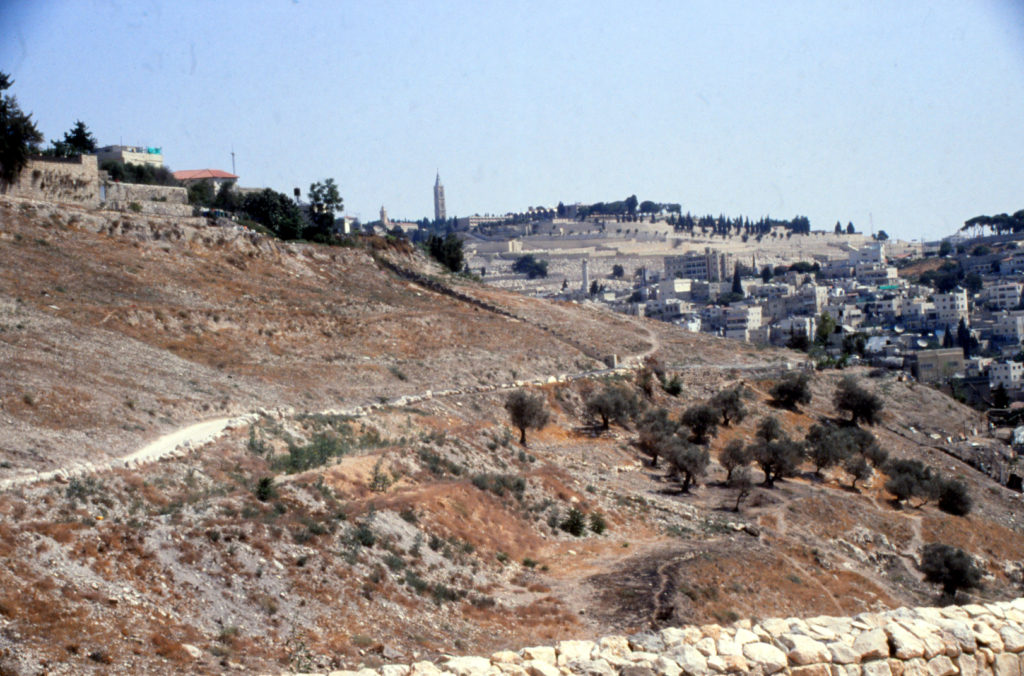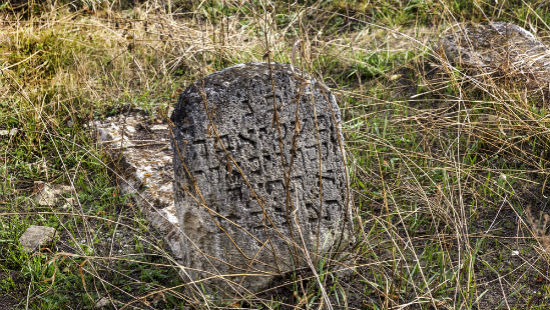
The Samboski cemetery is the only Jewish cemetery on Mount Zion in modern times. Located on the southern slope of the mountain, it was used to bury the less affluent. Among Jerusalem Jews it is considered ancient, yet its oldest documented tombstones were dated to the 18th century. The origin of the name is unknown: some have suggested it is a family name, though no family of that name is known today, while others believe it was named after the sambousak, a simple pastry whose half-round shape resembles the shape of the burial ground.
The cemetery was used mainly to bury the poor, and caves in the area were used to store (genizah) worn-out religious papers (shemot). The genizah procession took place every several years: “under a silk curtain (parokhet), sewn with golden threads, raised like a tent, the leaders of the community lead a torn Torah […] and behind them thirty three large sacks of torn holy books were carried […] and in a great grave dug on the foot of Mount Zion they buried them […] the tradition was passed through generations” (HaHavazelet, 1871). In 1925 the genizah caves were examined by Yehuda Leib Magnes, Nahum Slouschz, and Rabbi Simcha Assaf, commissioned by the Israel Exploration society.
Jewish men and women of all groups were buried in the Samboski cemetery, but a notable number of graves belong to Yemenite Jews. The Sepharadic Havra Kadisha used it to bury those who could not afford a burial plot, and during the British Mandate it went as far as to declare “Samboski burial free of all charge”. Few arranged to buy burial plots there in advance. Tombstones found in the area tend to have short inscriptions, and many are not dated. Luckily, lists of the buried were found in the hands of those responsible for burial – the Parnas family. Some interesting phrases can be found in the books kept by the Parnases, among them Mihutz (מחוץ, outside the fence, referring to people who committed suicide, or perhaps converters as well), Ashpital Taref (אשפיטאל טאריף, meaning Christian hospital), and reference to a Los Locos plot (Ladino for the crazy ones). Doron Herzog z”l, who dedicated many years to researching the history of the Sambsoki cemetery, estimates that thousands were buried there starting from the 17th century on. The books found with the Parnas family list almost 1400 people buried in Samboski between the end of the 19th century and mid-20th century.
Photographs and maps dating to the mid-19th century show many tombstones in the Samboski grounds. As years went by many were stolen and used for paving and construction, and others were gradually covered with soil or slid down the mountain slope. Only a few dozen are visible today. Different renovation initiatives were suggested during the 20th century, and the early 2000s even saw a proposal to bring Rabbi Nachman of Breslov’s remains to be buried in Samboski. The cemetery is now part of the Jerusalem Walls National Park (also called City of David National Park), and has undergone some restoration. In recent years memorial ceremonies for those buried in the forgotten Samboki cemetery have been held on the Jewish date 7 Addar, the memorial day for those whose burial place is unknown. Every autumn hundreds of squill flowers, also called Bulb of the Dead, sprout from the cemetery ground, like blooming memorial candles.






